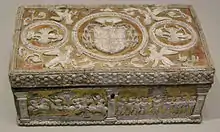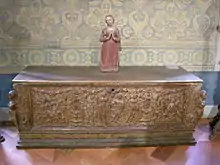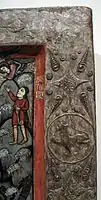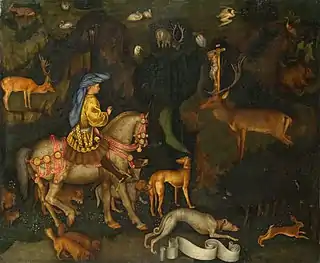Pastiglia
Pastiglia [paˈstiʎʎa], an Italian term meaning "pastework", is low relief decoration, normally modelled in gesso or white lead, applied to build up a surface that may then be gilded or painted, or left plain. The technique was used in a variety of ways in Italy during the Renaissance. The term is mostly found in English applied to gilded work on picture frames or small pieces of furniture such as wooden caskets and cassoni, and also on areas of panel paintings,[2] but there is some divergence as to the meaning of the term between these specialisms.



On frames and furniture the technique is in origin a cheaper imitation of woodcarving, metalwork or ivory carving techniques. Within paintings, the technique gives areas with a three-dimensional effect, usually those representing inanimate objects, such as foliage decoration on architectural surrounds, halos and details of dress, rather than parts of figures. In white lead pastiglia on caskets, the subject matter is usually classical, with a special emphasis on stories from Ancient Roman history.
White lead pastiglia
In reference to work on picture frames and paintings moulded and gilded gesso is still commonly described as pastiglia,[3] but in recent decades writers on furniture and the decorative arts tend to distinguish between this and "true" pastiglia, or white lead pastiglia[4] which is defined as being made from white lead powder, made by combining powdered lead and vinegar in an anaerobic environment, bound with egg white. White lead bound with oil or egg yolk was also the most common pigment for white paint. White lead pastiglia is very delicate and used for small areas only, but can produce very fine detail. It was mainly used on small caskets and boxes. Sections were typically pre-moulded, doubtless from metal matrices to judge from the crisp detail,[5] and glued on when hard. This was usually left unpainted, when it looked like carved ivory, which had been widely used to decorate boxes in Italy, by the Embriachi and others, but was by now less used, partly because it was too rare and expensive. The wood from which the main box was made was normally alder. It seems the term pastiglia for this only dates to the 17th century, after the technique had largely fallen from use. A scented variant called pasta di muschio ("musk paste") mixed musk perfume with the white lead, and was thought to be "aphrodisiacal", and so used for caskets given at a marriage,[6] and also other objects such as inkwells and frames for hand mirrors.[7]
White lead pastiglia was a north Italian speciality, produced between about 1450 and 1550. Six workshops were identified by Patrick M. De Winter, although their location remains uncertain; the Workshop of the Love and Moral Themes, whose products seem the most numerous, was possibly at Ferrara,[8] where the painter Cosimo Tura began his career gilding caskets.[9] Venice is also thought to have produced them. Other workshops identified by De Winter include the "Workshop of the main Berlin casket" and "Workshop of the Cleveland Casket".[10]
The subjects were typically classical, drawn from both mythology and Ancient Roman history (especially the early period covered by Livy), but biblical ones are also found. Compositions can often be shown to be borrowed from another medium, such as prints or bronze plaquettes,[11] and sections from the same mould can be found repeated, and used on more than one piece. The Victoria and Albert Museum has an armorial casket which is the only example that can be fairly closely dated, using the career of its owner, Cardinal Bernardo Clesio, as it must date to between his elevation as cardinal in 1530 and his resignation as Prince-bishop of Trent in 1538.[12] De Winter catalogued 115 white lead pastiglia caskets, only ten of which were over 20 cm high or deep. Another of this relatively large type was sold at auction in 2010.[13] Despite usually having locks, their thin alderwood frame meant that the caskets were probably too fragile to be used for really valuable items like jewellery, and they are thought to have been used for a variety of small objects including cosmetics and collections of seals, coins and the like.
In 2002, the Lowe Art Museum in Coral Gables, Miami held an exhibition of Pastiglia Boxes: Hidden Treasures of the Italian Renaissance from the collection of the Galleria Nazionale d'arte antica in Rome, and an 80-page exhibition catalogue was published in English and Italian.[14]
Gesso pastiglia
Gesso pastiglia is mostly found in Italy in the 14th to 16th centuries, where pastiglia on larger pieces of furniture such as cassoni, and on picture frames, was more likely to be gilded gesso than true white lead pastiglia. Both panel paintings and gilded frames had a thin flat layer of gesso as part of their preparation, to which the pastiglia decoration was added. On furniture and frames the gesso seems sometimes to have been carved from a thicker flat surface in a subtractive technique, and sometimes built up in an additive one, for smaller and larger areas respectively. Another additive technique was to simple pipe the gesso from a bag through a nozzle, like icing a cake, to give long round lines, often used as the tendrills in foliage designs.[15] It was then always gilded or painted, usually the former. The technique was very widely used in painted panels while gold-ground paintings remained the norm for altarpieces, along with a range of other techniques for decorating plain gilded surfaces such as stamping, engraving or scratching lines, and stippling, punching or pricking dots. In Gothic architectural frames for polyptychs, pastiglia is very commonly used to decorate small flat areas such as spandrels and behind scalloped edges. The technique is described at the end of the technical handbook by Cennino Cennini, whose own paintings made use of it, although he does not use the term himself.[16]
With the decline of the gold-ground style it became rarer within paintings, as opposed to frames, but was sometimes used for highlights, or a particular purpose. A famous portrait by Sandro Botticelli, who trained as a goldsmith, Portrait of a Man with a Medal of Cosimo the Elder (Uffizi, c. 1474), has the medal the subject is holding executed in gilded pastiglia, which apparently is an impression moulded from the original matrix for the metal medals, some of which survive.[17]
Pisanello frequently used the technique; his The Vision of Saint Eustace (National Gallery, probably about 1540) shows a very fancily dressed courtier on a horse, and has pastiglia highlights on medallions on the horse harness, and the gold mounts on his hunting horn and his spurs, all gilded and representing pieces of goldsmith work.[18] Such highlights are seen on other paintings by Pisanello, who was the leading medalist of his day, and familiar with modelling and casting techniques. Similar pastiglia medallions on horse-harness are found in the fresco Saint George and the Princess (Verona), and the Apparition of the Virgin to Saints Anthony Abbot and George (National Gallery).[19] In his gold-ground Madonna of the Quail (Verona, attributed), the pastiglia is on the halos and borders of the Virgin's dress at neck and cuff, her crown, and in foliage decoration to the gold "sky", all typical locations in earlier religious paintings.
A generation after Pisanello, the conservative Carlo Crivelli continued to use pastiglia highlights in his panels,[20] and it is used in Vincenzo Foppa's Adoration of the Kings (National Gallery) at the end of the century, in the crowns and gifts of the Three Kings.[21]
The technique is rarer in fresco, but there are extensive areas of patterns in the cycle of the life of Queen Theodelinda in Monza Cathedral by the Zavattari family around 1440, no doubt using normal fresco plaster.[22] It was perhaps more common in decorating secular palaces than churches, but the vast majority of Gothic palace decorations are now lost. In England, it was used in the Painted Chamber of Westminster Palace as well as the much-damaged Westminster Retable painted panel,[23] and in Early Netherlandish painting used in works such as the Seilern Triptych attributed to Robert Campin, where the gold skies have elaborate patterns of foliage, with a different design on each panel.[24]
By about 1500, and with the advent of painting on more flexible canvas, which would not be a suitable support for pastiglia, use in painting disappears, but it continued on picture frames, where Renaissance gesso pastiglia generally consisted of vegetal motifs.[25] During the 16th century cassoni and some frames became more massive, and woodcarving replaced pastiglia.[26]
Cassoni

Gesso pastiglia was very widely used on cassoni from the inception of the form in the 14th century. Early decoration tended to be repeated motifs derived from textile designs. Early cassoni were mostly either entirely painted or entirely decorated in gilded pastiglia, but by the 15th century painted panels were inset in elaborate pastiglia surrounds of mouldings - many of the paintings have now been detached and hang in museums. The subjects used for decorating cassoni in either medium had considerable overlap with those on white lead pastiglia caskets, with a heavy bias towards mythology. The paintings were typically by specialized workshops, of less quality than the leading local masters, but in the 15th century, many important painters sometimes produced them. Vasari complained that by his day artists looked down on this work, and by then more massive and elaborately carved walnut cassoni were in fashion.[27]
The Victoria and Albert Museum has a Florentine example of a class of "coffrets" intermediate between caskets and cassoni, which is known by the motto Onesta e bella on its top, and would have been an engagement present from the future husband to his bride, formally presented to her by a representative from his family at her house, filled with small presents from the bridegroom's family. Smaller white lead pastiglia caskets were probably also used on such occasions.[28] Made in about 1400, it is only 23 cm high and 61.5 cm wide and decorated with gilded pastiglia scenes made from gesso dura of courtly hunting and jousting on a painted blue field; these were apparently hand-modelled, not cast.[29]
Plaquettes in bookbinding
Although the term pastiglia is not typically used to describe them, it is appropriate to mention "plaquette" bookbindings here. These are luxury leather bindings which incorporate, normally at the centre of the front cover, small inset plaquettes or roundels with designs in relief, which may be painted in colour. They appear towards the end of the 15th century, probably in Florence or Padua,[30] and were at first used for special presentation volumes. Initially the designs were taken from antique carved gems. It was the famous, and rich, French bibliophile Jean Grolier who was apparently the first to use them systematically for his own books, while he was based in Milan as Treasurer for the French occupation; probably he began to commission them in 1510. He was also the first to use original designs, several of which showed scenes from Livy; altogether 25 Italian plaquette bindings for Grolier survive.[31]
Some just use stamped leather, but for others the material used is variously described as "a sort of gesso mixed with varnish",[32] or just "gesso",[33] but these plaquettes can have extremely fine detail. What may have been Grolier's first such binding has a plaquette with 11 human figures and an architectural setting in a scene about two inches (50 mm) wide, showing Marcus Curtius leaping into the hole, the same subject as on the British Museum casket illustrated at the start of the article.[34]
 On the frame of a Romanesque Catalan altarpiece
On the frame of a Romanesque Catalan altarpiece The Vision of Saint Eustace, Pisanello, with pastiglia on the metal parts of the horse trapping
The Vision of Saint Eustace, Pisanello, with pastiglia on the metal parts of the horse trapping
 Detail of the Seilern Triptych, Robert Campin, c. 1425
Detail of the Seilern Triptych, Robert Campin, c. 1425
Notes
- British Museum page
- National Gallery glossary; the term is sometimes italicized in English, and sometimes not, though in "white lead pastiglia" more often not.
- For example: Cohen, 183, here and by the National Gallery
- De Winter and Manni led the new distinction. Campbell's contributors for "Cassone" and "Pastiglia" use different definitions, the latter saying (p.194) "Cassone" decoration, described from the late 19th century onwards as pastiglia, is in fact gilt gesso. Pastiglia would be too small and fragile for a large cassone".
- John Fleming and Hugh Honour, Dictionary of the Decorative Arts, s.v. "Pastiglia".
- Metropolitan Museum casket; they seem to say the casket is made with both gesso and white lead paste.
- Thornton, 109
- Campbell, 194, citing Manni
- Thornton, 109
- Sotheby's; the Cleveland Casket
- Bull, 39; see for example the British Museum page on their box illustrated here, where one element is copied from a bronze; Campbell, 194
- V&A Museum
- Sotheby's London, 7 December 2010, Sale L10233, Lot 31, sold for £163,250 inc. premium, Sale catalogue online. This price was exceptional; compare this lot at Christie's in 2006
- See further reading
- Penny, Nicholas, A Closer Look: Frames, 80, 2011, Yale University Press, ISBN 1-85709-440-9, ISBN 978-1-85709-440-4; Penny avoids the term "pastiglia" in discussing picture frames, talking of piped and "press-cast" gesso.
- von Imhoff, 142
- Cohen, 113. The medal is not reversed, so was either from the matrix, or made by using a new matrix cast from a medal.
- Syson and Gordon, 158
- Syson and Gordon, 22 & 140
- Cohen, 113
- Dunkerton and Plazzotta
- Syson and Gordon, 58, discusses and illustrates the cycle, without mentioning the pastiglia; Monza Duomo museum
- Všetečková
- Courtauld, The Seilern Triptych
- Example in the Victoria & Albert Museum
- Osborne, 125-126
- Campbell, 205-207; Bull, 38-39; Osborne, 125-126
- Ajmar-Wollheim, Marta; Dennis, Flora, At home in Renaissance Italy, 127, 2006, Victoria and Albert Museum, ISBN 1-85177-488-2, ISBN 978-1-85177-488-3
- V&A Coffret "onesta e bella"
- Diehl, 83 says Florence; Hobson, 13 says Padua
- Hobson, 13-21
- Diehl, 83
- Marks, 40
- BL G 9026, De Medicina, by Aulus Cornelius Celsus; British Library Bindings database, with good images. Marks, 40 and Hobson, 18 both illustrate the cover.
References
| Wikimedia Commons has media related to Pastiglia. |
- Bull, Malcolm, The Mirror of the Gods, How Renaissance Artists Rediscovered the Pagan Gods, Oxford UP, 2005, ISBN 0-19-521923-6
- Campbell, Gordon, The Grove Encyclopedia of Decorative Arts, Volume 1, s.v. Cassone and Pastiglia, Oxford University Press US, 2006, ISBN 0-19-518948-5, ISBN 978-0-19-518948-3
- Cohen, Beth, in Cohen, Beth and Lansing-Maish, Susan, The Colors of Clay: Special Techniques in Athenian Vases, 2008, Getty Publications, ISBN 0-89236-942-6, ISBN 978-0-89236-942-3, Google books
- Diehl, Edith, Bookbinding, its background and technique, Volume 1, 1980, Courier Dover Publications, ISBN 0-486-24020-7, ISBN 978-0-486-24020-6, google books
- Dunkerton, Jill & Plazzotta, Carol, "Vincenzo Foppa's Adoration of the Kings", National Gallery Technical Bulletin, Volume 22, 2001
- Hobson, Anthony, Renaissance book collecting: Jean Grolier and Diego Hurtado de Mendoza, their books and bindings, 1999, Cambridge University Press, ISBN 0-521-65129-8, ISBN 978-0-521-65129-5, google books
- Marks, P. J. M., Beautiful Bookbindings, A Thousand Years of the Bookbinder's Art, 2011, British Library, ISBN 978-0-7123-5823-1
- Osborne, Harold (ed), The Oxford Companion to the Decorative Arts, s.v. Cassone, 1975, OUP, ISBN 0-19-866113-4
- Syson, Luke & Gordon, Dillian, "Pisanello, Painter to the Renaissance Court", 2001, National Gallery Company, London, ISBN 1-85709-946-X
- Thornton, Peter, Schatzkästchen und Kabinettschrank. Möbel für Sammler (review of Berlin exhibition), Journal of the History of Collections, 1991 3(1)
- Všetečková, Zuzana, "Plastic Elements in Wall Paintings of the 12th-14th Centuries", Technologia artis (online journal)
- von Imhoff, Hans-Christoph, Review of Seeing through Paintings: Physical Examination in Art Historical Studies by Andrea Kirsh and Rustin S. Levenson, Studies in Conservation, 2002, Vol. 47, No. 2
Further reading
- De Winter, P. M., "A little-known creation of Renaissance decorative arts: the white lead pastiglia box", Saggi e Memorie di Storia dell'Arte 14, 1984, pp. 7–42
- Hildburgh, W. L. "On some Italian Renaissance caskets with Pastiglia decorations", The Antiquaries Journal, vol. XXVI, July–October 1946
- Manni, Graziano, Mobili in Emilia, Modena, 1986
- Zaccagnini, Marisa, Pastiglia Boxes: Hidden Treasures of the Italian Renaissance, 2002, Lowe Art Museum, Miami, ISBN 88-7038-379-2, ISBN 978-88-7038-379-9
